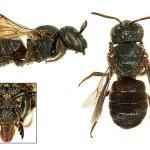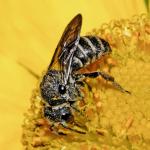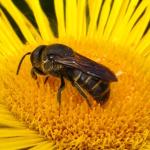Apis aterrima PANZER 1798; Stelis moravica TKALCŮ, 1971; Apis contracta PANZER 1804; Stelis (Stelis) moravica TKALCU, 1970; Stelis beaumonti NOSKIEWICZ 1962;
The four species of Stelis which occur in the British Isles are all rare bees, in contrast to some other cleptoparasitic bee genera which contain species which are often locally common.
Widely distributed throughout much of southern Britain, from Kent to Cornwall, northwards to Gwynedd and Suffolk. In June 1974, the late A B Duncan collected several specimens of this species in his garden at Castlehill, near Dumfries, Dumfries and Galloway. This is the only species of Stelis which is known from the Channel Islands, where it has been found on Jersey (date unknown - not mapped). The distribution map suggests a species that is in decline, with comparatively few recent records.
A Nationally Notable species (Nb) (Falk 1991).
To be expected wherever its host species occur in Britain.
Single-brooded; mid-June to late August.
In Britain, this is apparently a cleptoparasite of three species of Megachilinae. These are Anthidium manicatum (specimens of the Stelis reared from a nest of this species are in the Natural History Museum, London), Osmia leaiana (Smith, 1876; Saunders, 1896; Perkins, 1923; Hallett, 1928) and O. aurulenta (Smith, 1876).
Common mallow (Malva sylvestris), bird's-foot-trefoil (Lotus corniculatus), bramble (Rubus fruticosus agg.), wild marjoram (Oreganum vulgare), ragwort (Senecio jacobaea), common fleabane (Pulicaria dysenterica), yarrow (Achillea millefolium), spear thistle (Cirsium vulgare) and hawkweed (Hieracium sp.).
Profile written: 1998
Proofed: February 2012




